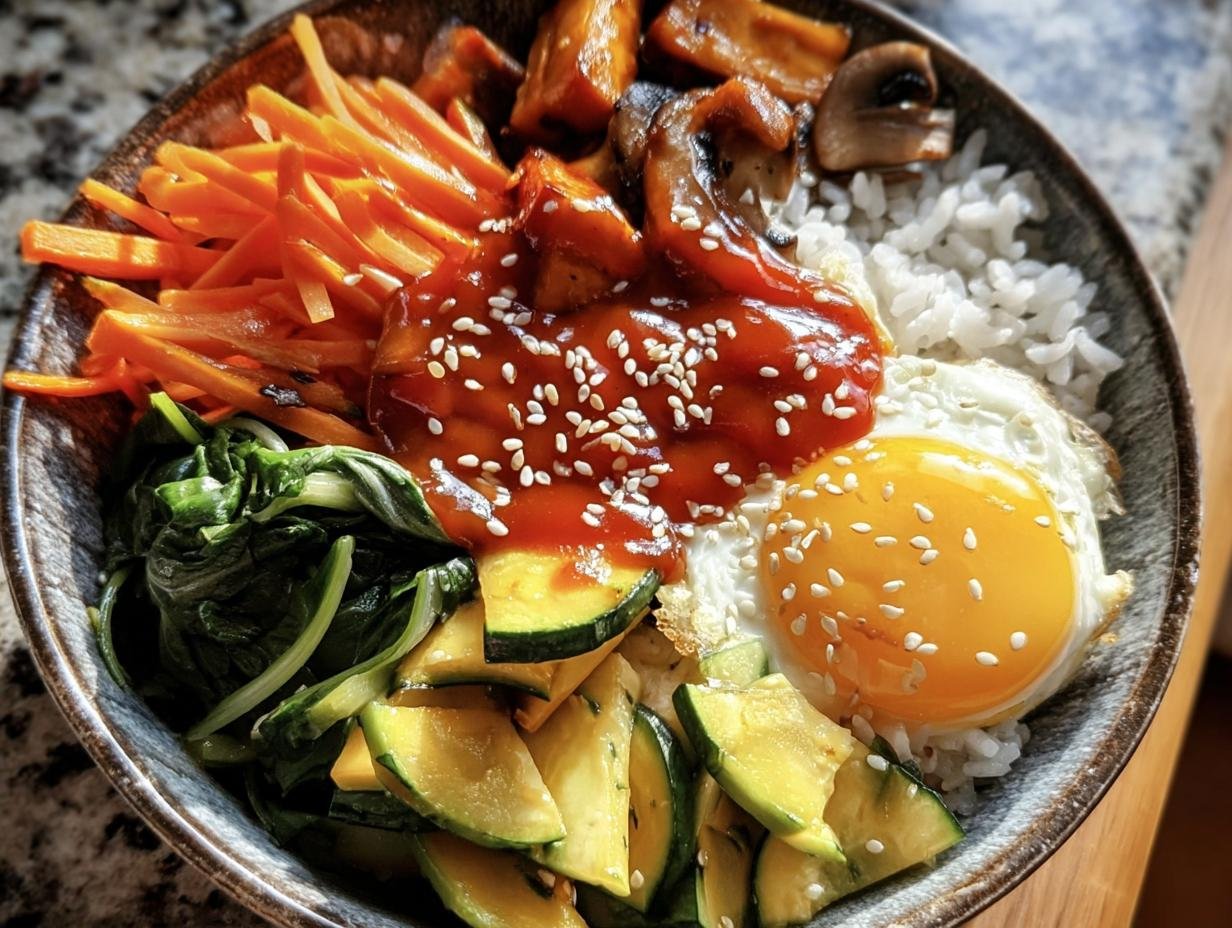Oh, Korean food! It just has a way of making everything feel so vibrant and alive, doesn’t it? And when it comes to quick, healthy meals that still pack a serious flavor punch, you just can’t beat a good bibimbap. I’ve made this Korean Veggie Bibimbap Bowl countless times, especially on those busy weeknights when I crave something nourishing but don’t have hours to spend in the kitchen. It’s my go-to for a reason – it’s super adaptable, incredibly pretty with all those colors, and honestly, so satisfying. Plus, putting it all together feels like a little work of art!
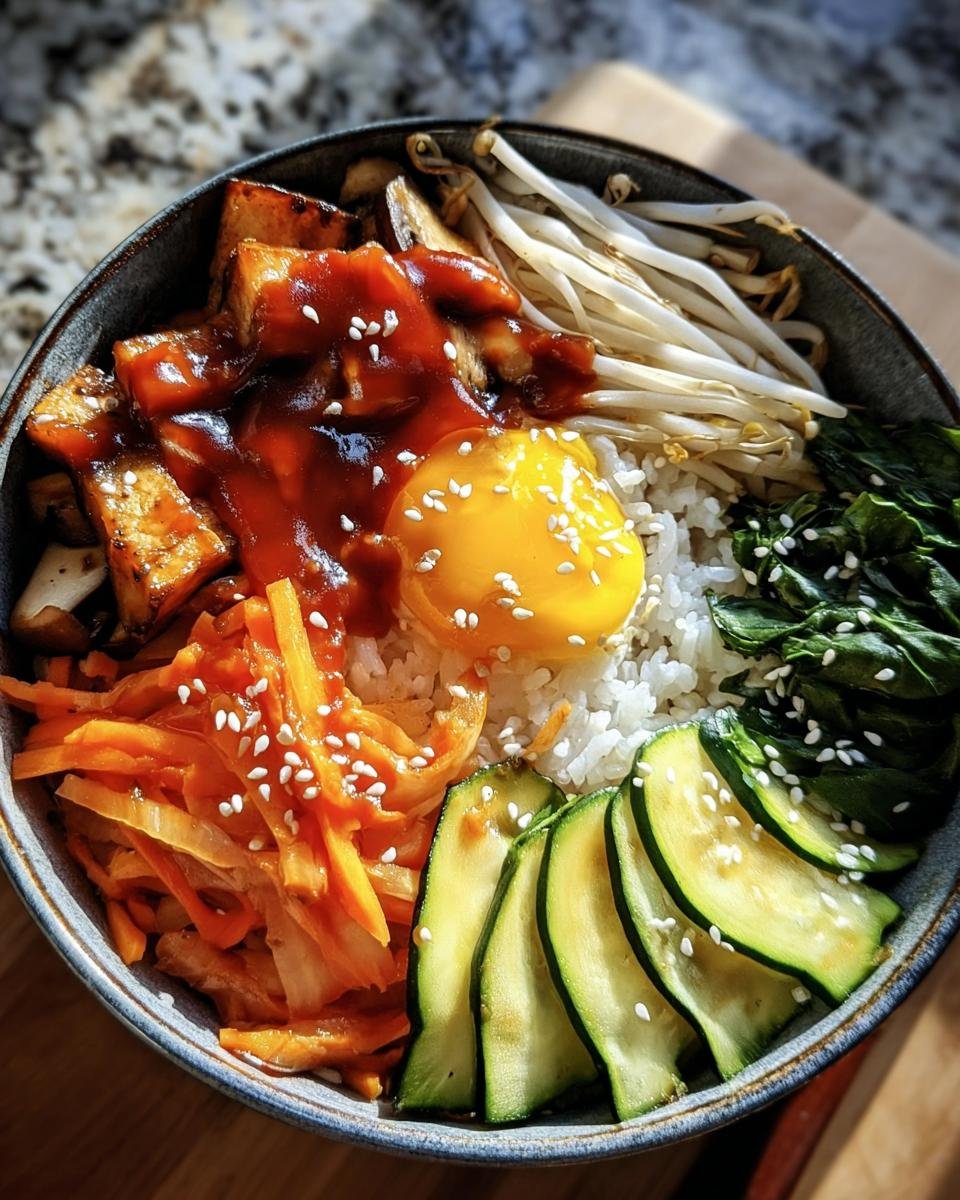
Why You’ll Love This Korean Veggie Bibimbap Bowl
Trust me, this bibimbap is a game-changer. Here’s why you’ll be making it again and again:
- Super Easy: Seriously, even if you’re new to cooking, you can whip this up! Most of the magic happens while the rice is cooking.
- Bursting with Flavor: That savory-spicy sauce tying everything together? Perfection. You get a little bit of everything in every bite.
- So Healthy and Fresh: Packed with colorful veggies, it’s a delicious way to get your nutrients. It feels good to eat something so vibrant!
- Totally Customizable: Don’t have shiitake mushrooms? No problem! This recipe is super forgiving. Swap in whatever veggies you have in the fridge. That’s the beauty of it!
Gather Your Ingredients for Korean Veggie Bibimbap Bowl
Alright, let’s get our ingredients ready! This is where the magic starts to happen. Having everything prepped makes the whole cooking process a breeze, so let’s dive in. Make sure you have these key players ready to go:
For the Rice
The foundation for our gorgeous bowl!
- 1 cup short-grain rice: Make sure to rinse it really well before cooking! That helps get rid of excess starch.
- 1.5 cups water: For perfectly fluffy rice.
For the Vegetables
This is where all the color and freshness comes in!
- 1 medium carrot: We want these julienned, so cut into thin matchsticks.
- 1 cup shiitake mushrooms: Sliced them up for that lovely meaty texture.
- 1 cup spinach: Fresh and vibrant!
- 1 medium zucchini: Julienne this too, just like the carrot.
- 1/2 cup bean sprouts: These add a nice little crunch.
- 2 tbsp sesame oil: We’ll split this – half for sautéing, half for the sauce.
- 1 clove garlic: Minced super fine adds so much flavor.
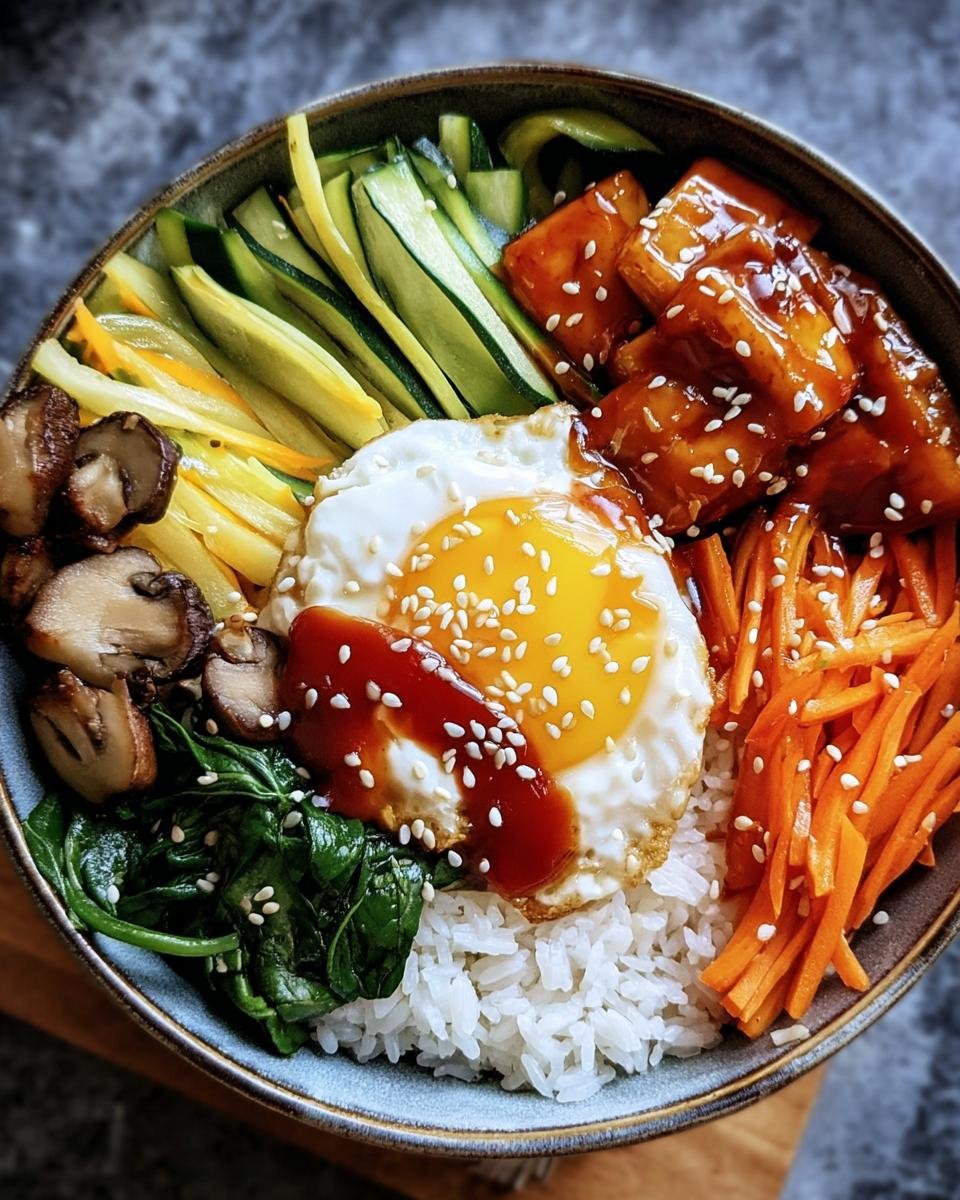
For the Sauce
This is the flavor powerhouse! Whisk it all together for that irresistible kick.
- 2 tbsp gochujang: This is the star Korean chili paste, find it at an Asian market or well-stocked grocery store!
- 1 tbsp sesame oil: For that nutty depth.
- 1 tbsp rice vinegar: Just a touch of tanginess.
- 1 tsp sugar: To balance out the heat and salt.
- 1 tsp soy sauce: For that essential savory umami.
Optional Toppings
These really elevate the bowl, but they’re totally up to you!
- 2 eggs: Fried sunny-side up or over easy are my favorites here.
- Toasted sesame seeds: A little sprinkle for crunch and nutty flavor.
You can find all sorts of amazing vegetarian recipes, but this bibimbap really hits the spot for healthy, hearty eating!
Essential Equipment for Your Korean Veggie Bibimbap Bowl
You don’t need much fancy stuff for this! Just a few kitchen staples will do. Having these on hand means you’re ready to whip up this yummy Korean Veggie Bibimbap Bowl in no time. I always make sure my trusty skillet and saucepan are clean and ready!
- Large skillet: Perfect for sautéing all those colorful veggies.
- Medium saucepan: For cooking your rice just right.
- Mixing bowls: A couple of these are handy for prep and mixing up that delicious sauce.
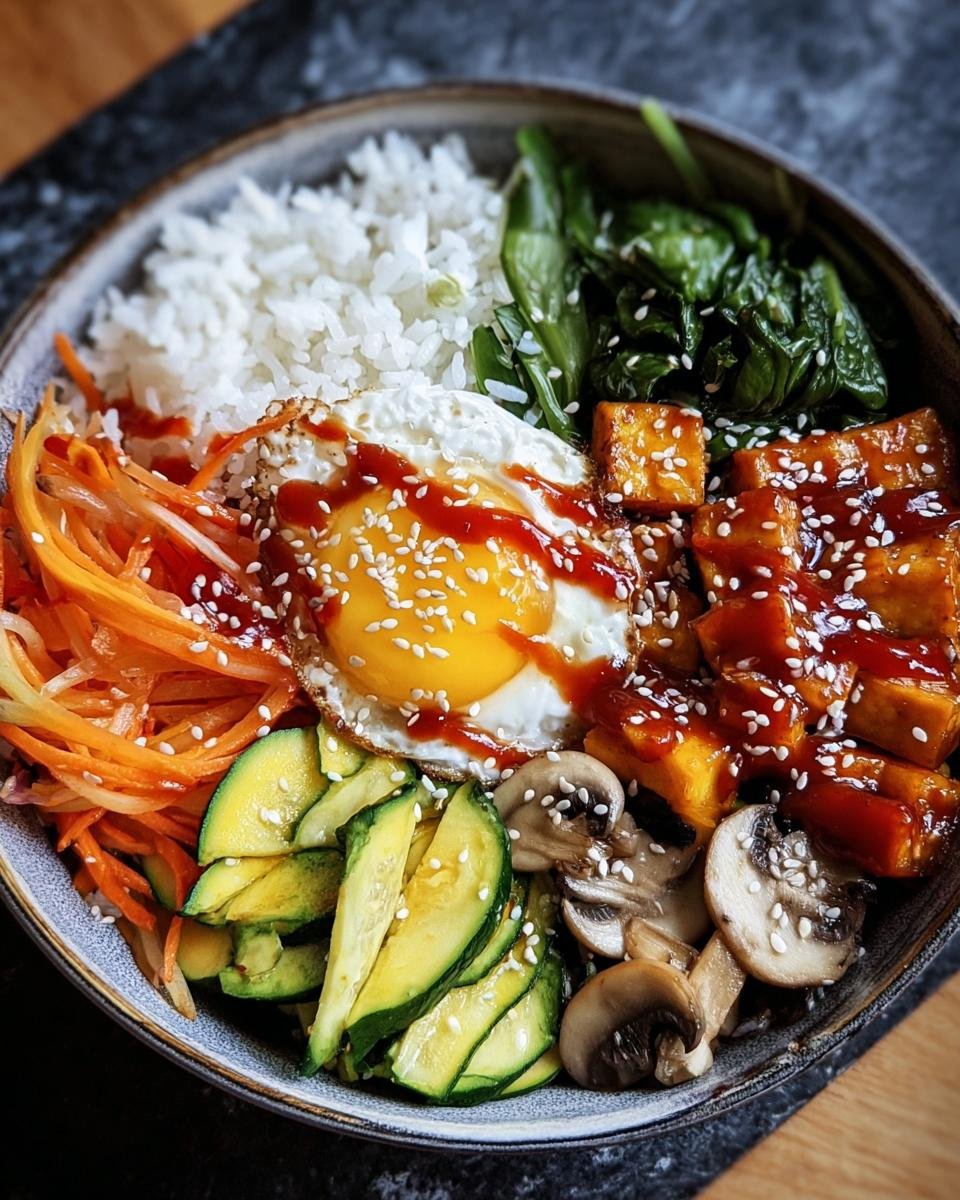
Step-by-Step Guide to Making Korean Veggie Bibimbap Bowl
Alright, let’s get cooking! Following these steps will have you enjoying your beautiful Korean Veggie Bibimbap Bowl in no time. It’s all about building those layers of flavor and color.
Cooking the Rice Base
First things first, let’s get that rice going! Cook your rinsed short-grain rice with 1.5 cups of water in your medium saucepan according to its package directions. Once it’s all fluffy and tender, give it a good fluff with a fork. This is the perfect canvas for our bibimbap creation!
Preparing the Vibrant Vegetables
Now for the fun part – the veggies! Grab your large skillet and pop in about 1 tablespoon of sesame oil over medium-high heat. Toss in your julienned carrots and zucchini first. Stir-fry them for about 3-4 minutes until they’re tender but still have a little bite. Next, add your sliced shiitake mushrooms and that minced garlic. Cook for another 2-3 minutes until those mushrooms are nice and soft. In a separate little bowl, quickly blanch your bean sprouts in boiling water for just a minute, then drain them. Wipe out your skillet (or use a second one!), add the remaining 1 tablespoon of sesame oil, and toss in your spinach. Cook it until it’s just wilted – that’s usually only 1-2 minutes. Stir in your drained bean sprouts with the spinach to keep them nice and crisp.
Crafting the Flavorful Bibimbap Sauce
This sauce is KEY! In a small bowl, just whisk together your gochujang, the other tablespoon of sesame oil, rice vinegar, sugar, and soy sauce. Give it a good stir until it’s all combined into a smooth, delicious sauce. Taste it and adjust if you like it a little spicier or sweeter!
Assembling Your Korean Veggie Bibimbap Bowl
Time to make it beautiful! Divide your fluffy cooked rice evenly between your two bowls. Now, artfully arrange your colorful cooked vegetables on top of the rice. I like to arrange them in little sections so you can see all the different colors clearly. Drizzle that amazing bibimbap sauce all over those lovely veggies. The grand finale? Top each bowl with a perfectly fried egg (sunny-side up is my personal favorite for the runny yolk!) and then sprinkle on some toasted sesame seeds for a little extra flair. Don’t forget to check out this high-protein rice recipe if you ever need another rice idea!
Tips for the Best Korean Veggie Bibimbap Bowl
Alright, let’s make this Korean Veggie Bibimbap Bowl absolutely sing! It’s already pretty simple, but a few little tricks can really make it shine. I’ve learned these by making it countless times, and boy, do they make a difference!
- Don’t Overcook the Veggies: The key here is “tender-crisp.” You want them to have a little chew, not be mushy. That slight crunch adds so much to the texture of the bowl.
- Prep is Your Friend: Get everything (and I mean *everthing*) chopped, sliced, and measured before you even turn on the stove. Bibimbap cooking moves fast once you start sautéing!
- The Egg is Crucial: Seriously, don’t skip the egg if you can help it. That runny yolk mixes into the sauce and rice, creating this incredible, silky richness. So good!
- Taste Your Sauce: Gochujang can vary in spice and sweetness. Give your sauce a quick taste before you drizzle it and adjust the sugar or soy sauce if needed.
And if you’re ever looking for other fresh, veggie-packed ideas, check out this corn and zucchini chowder recipe – it’s another one of my favorites for bright, healthy flavors!
Ingredient Notes and Substitutions
Sometimes you might be missing an ingredient, or maybe you just want to mix things up! Don’t sweat it. This Korean Veggie Bibimbap Bowl is super forgiving.
Gochujang: This is the heart of the sauce, so if you can find it, definitely use it! If you absolutely can’t find it, you could try a mix of sriracha and a little extra miso for depth, but it won’t be quite the same. Just know that gochujang adds a unique savory, slightly sweet, and spicy kick that’s totally Korean.
Veggies: Oh, this is where you can go wild! Don’t have zucchini? Use julienned bell peppers or even some thinly sliced broccoli florets. Edamame is also a fantastic addition for extra protein and color. If you can’t find bean sprouts, that’s okay too – the dish will still be delicious. Just use what you’ve got!
Looking for more veggie-packed ideas? You’ll adore my zucchini corn chowder recipe too!
Frequently Asked Questions About Korean Veggie Bibimbap Bowl
Got questions about whipping up this amazing Korean Veggie Bibimbap Bowl? I totally get it! Here are some things folks often ask, and my two cents on them. These are all great questions that pop up when you’re thinking about making this tasty dish!
Can I make Korean Veggie Bibimbap Bowl ahead of time?
You absolutely can prep some parts ahead of time, which is a lifesaver! Cook the rice and chop all your veggies a day in advance. You can even sauté the vegetables separately and store them in airtight containers in the fridge. Then, all you have to do is reheat them quickly (or eat them cold, which is pretty good too!) and assemble your bowls. The sauce can also be made a day or two ahead. Just remember to fry your egg fresh right before serving for that perfect runny yolk!
What are the best vegetables for Bibimbap?
Honestly, the best vegetables are the ones you love and have on hand! The recipe calls for carrot, shiitake mushrooms, spinach, zucchini, and bean sprouts, which create a fantastic mix of colors and textures. But really, you can throw in almost anything! Thinly sliced bell peppers (any color!), blanched broccoli florets, snap peas, or even some sautéed edamame would be wonderful. The key is to cut them into bite-sized, uniform pieces so they cook evenly and look pretty layered in the bowl. Don’t be afraid to experiment!
Is Bibimbap healthy?
Totally! That’s one of the best things about this Korean Veggie Bibimbap Bowl. It’s packed with fiber and nutrients from all the colorful vegetables. The gochujang sauce has a good kick of spice and flavor without being loaded with unhealthy fats. When you top it with a lean protein like a fried egg or even some grilled chicken or tofu, it becomes a really well-rounded, satisfying, and incredibly healthy meal. It’s definitely one of my favorite ways to eat my veggies!
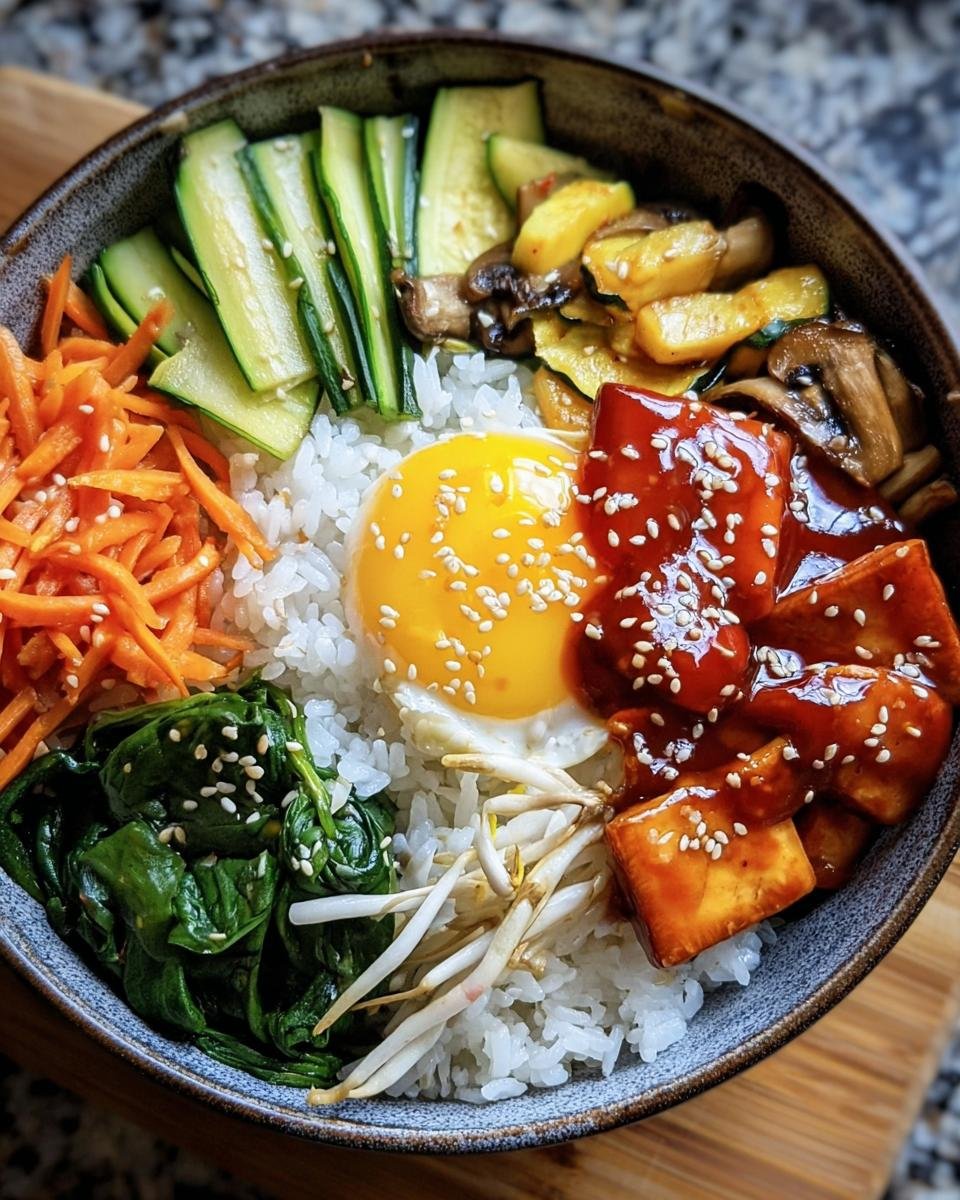
If you’re looking for more healthy bowl ideas, you might like this Taco Rice Bowl or this Teriyaki Chicken Avocado Rice!
Nutritional Information
Okay, let’s talk numbers! Please remember these are just estimates, as the exact nutritional values for your Korean Veggie Bibimbap Bowl can really change depending on the specific ingredients you use and how big you make your bowls. But generally, this dish is fantastic!
Per serving (for 2 servings):
- Calories: Around 450
- Protein: Around 15g
- Carbohydrates: Around 70g
- Fat: Around 15g
It’s a really balanced meal, especially when loaded with all those veggies!
Share Your Korean Veggie Bibimbap Bowl Creations
I just LOVE seeing what you all whip up in your kitchens! If you make this Korean Veggie Bibimbap Bowl, please, please, please share your creations with me. Snap a pic and tag me or leave a comment below. I’d be thrilled to hear how it turned out for you, or any fun twists you added! You can always find out more about me here: learn more.
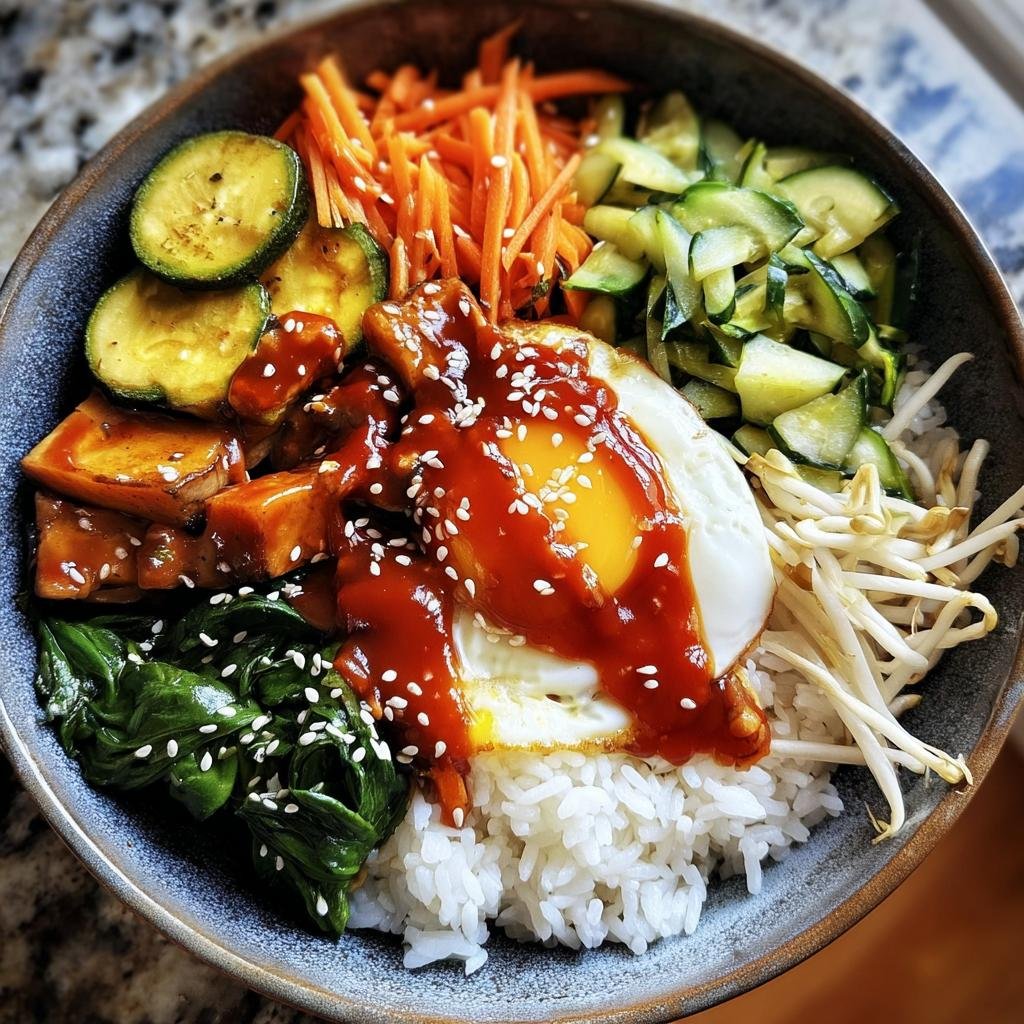
Korean Veggie Bibimbap Bowl
Ingredients
Equipment
Method
- Cook the rice according to package directions. Fluff with a fork and set aside.
- While the rice cooks, prepare the vegetables. Heat 1 tablespoon of sesame oil in a large skillet over medium-high heat. Add the carrots and zucchini and stir-fry for 3-4 minutes until tender-crisp.
- Add the shiitake mushrooms and minced garlic to the skillet. Cook for another 2-3 minutes until mushrooms are softened.
- In a separate small bowl, blanch the bean sprouts in boiling water for 1 minute, then drain. In the same skillet (wiped clean), add the remaining 1 tablespoon of sesame oil. Add the spinach and cook until just wilted, about 1-2 minutes. Stir in the blanched bean sprouts.
- In a small bowl, whisk together all the sauce ingredients: gochujang, sesame oil, rice vinegar, sugar, and soy sauce.
- To assemble, divide the cooked rice between two bowls. Arrange the cooked vegetables and spinach mixture on top of the rice.
- Drizzle the bibimbap sauce over the vegetables. Top with a fried egg and sprinkle with toasted sesame seeds, if desired.

